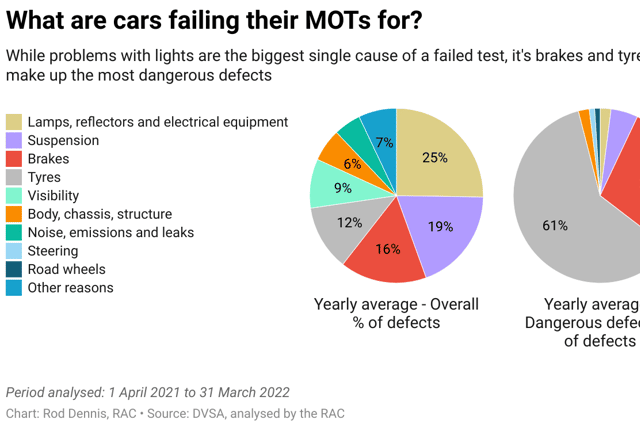MOT failures: Brakes and tyres most common ‘dangerous’ defects as 1 in 10 cars fails on serious faults
and live on Freeview channel 276
Faulty brakes and tyres are the “overwhelming” cause of dangerous MOT failures, according to new figures.
A third of all MOT tests resulted in a fail between 2021 and 2022 but 1 in 10 - equivalent to 2.4 million vehicles - was due to a “dangerous” defect that means the vehicle can’t be driven until it is repaired. And the vast majority of those - 88% - related to the two critical components.
Advertisement
Hide AdAdvertisement
Hide AdThe latest figures from the Driver and Vehicle Standards Agency (DVSA) showed that 7.3m cars and small vans failed their MOT in the 12 months to March 2022 and were revealed shortly after the government proposed extending the period before a car needs an MOT.
Lamps, reflectors and indicators remained the most common overall cause of MOT failures, behind a quarter of all test refusals between March 2021 and 2022, while faulty or broken suspensions represented just under a fifth (18.3%) of all failures.
Brakes and tyres were the third and fourth most common reasons for failures - responsible for 17% and 12% of all test refusals - while bad visibility, including damaged windscreens, was the fifth most frequent fault.
The data was obtained by the RAC and its head of roads policy Nicholas Lyes warned that despite the cost of living crisis, drivers needed to stay on top of vehicle maintenance. He commented: “Many drivers dread taking their vehicle for its annual MOT for fear they could end up having to spend lots of money on repairs in order to get it to pass. This is no doubt the case for an unlucky third of owners whose vehicles fail their MOTs initially.
Advertisement
Hide AdAdvertisement
Hide Ad“Drivers should never ignore dashboard warning lights as they could end up putting themselves or others at risk and costing themselves a lot of money with a bigger repair bill than necessary had they acted straight away. Additionally, routine servicing helps reduce the chance of a vehicle failing its MOT as it includes a host of important basic checks.”


All cars require their first MOT after three years and then annually until they are 40 years old. However, in January the Department for Transport began a consultation on extending the window before a car’s first MOT to four years and lengthening the time between tests, raising concerns that it could result in hundreds of thousands more unsafe cars on the road.
Lyes added: “With more than 7.3m small passenger vehicles initially failing their MOTs, and alarmingly around 2.4m of these failures having at least one dangerous defect, the idea of relaxing rules on MOT tests could very well result in making our roads far more dangerous with the number of unroadworthy vehicles increasing. We hope the Government has finally consigned such an idea to the bin.”
Comment Guidelines
National World encourages reader discussion on our stories. User feedback, insights and back-and-forth exchanges add a rich layer of context to reporting. Please review our Community Guidelines before commenting.
